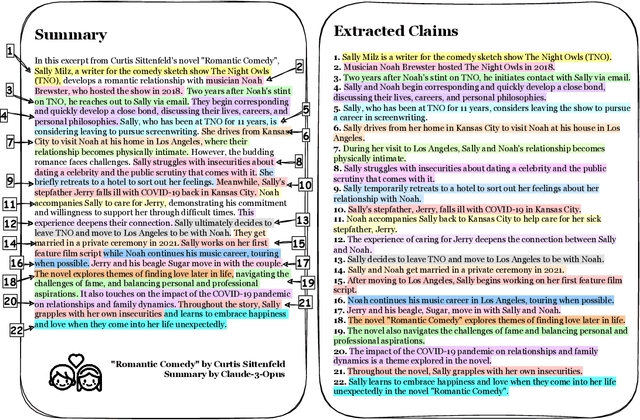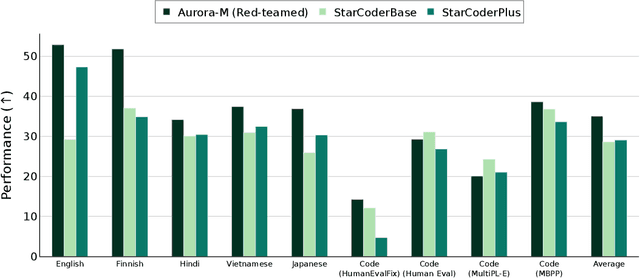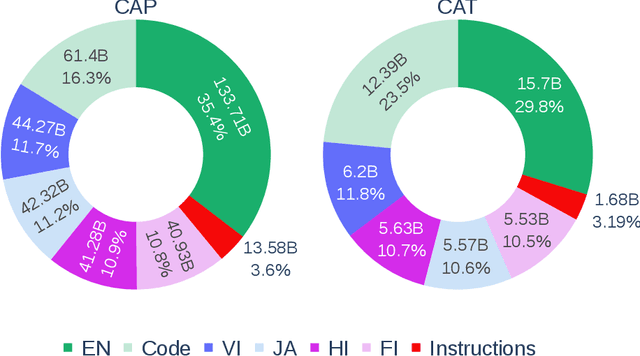Marzena Karpinska
One ruler to measure them all: Benchmarking multilingual long-context language models
Mar 03, 2025Abstract:We present ONERULER, a multilingual benchmark designed to evaluate long-context language models across 26 languages. ONERULER adapts the English-only RULER benchmark (Hsieh et al., 2024) by including seven synthetic tasks that test both retrieval and aggregation, including new variations of the "needle-in-a-haystack" task that allow for the possibility of a nonexistent needle. We create ONERULER through a two-step process, first writing English instructions for each task and then collaborating with native speakers to translate them into 25 additional languages. Experiments with both open-weight and closed LLMs reveal a widening performance gap between low- and high-resource languages as context length increases from 8K to 128K tokens. Surprisingly, English is not the top-performing language on long-context tasks (ranked 6th out of 26), with Polish emerging as the top language. Our experiments also show that many LLMs (particularly OpenAI's o3-mini-high) incorrectly predict the absence of an answer, even in high-resource languages. Finally, in cross-lingual scenarios where instructions and context appear in different languages, performance can fluctuate by up to 20% depending on the instruction language. We hope the release of ONERULER will facilitate future research into improving multilingual and cross-lingual long-context training pipelines.
OverThink: Slowdown Attacks on Reasoning LLMs
Feb 05, 2025Abstract:We increase overhead for applications that rely on reasoning LLMs-we force models to spend an amplified number of reasoning tokens, i.e., "overthink", to respond to the user query while providing contextually correct answers. The adversary performs an OVERTHINK attack by injecting decoy reasoning problems into the public content that is used by the reasoning LLM (e.g., for RAG applications) during inference time. Due to the nature of our decoy problems (e.g., a Markov Decision Process), modified texts do not violate safety guardrails. We evaluated our attack across closed-(OpenAI o1, o1-mini, o3-mini) and open-(DeepSeek R1) weights reasoning models on the FreshQA and SQuAD datasets. Our results show up to 18x slowdown on FreshQA dataset and 46x slowdown on SQuAD dataset. The attack also shows high transferability across models. To protect applications, we discuss and implement defenses leveraging LLM-based and system design approaches. Finally, we discuss societal, financial, and energy impacts of OVERTHINK attack which could amplify the costs for third-party applications operating reasoning models.
OVERTHINKING: Slowdown Attacks on Reasoning LLMs
Feb 04, 2025Abstract:We increase overhead for applications that rely on reasoning LLMs-we force models to spend an amplified number of reasoning tokens, i.e., "overthink", to respond to the user query while providing contextually correct answers. The adversary performs an OVERTHINK attack by injecting decoy reasoning problems into the public content that is used by the reasoning LLM (e.g., for RAG applications) during inference time. Due to the nature of our decoy problems (e.g., a Markov Decision Process), modified texts do not violate safety guardrails. We evaluated our attack across closed-(OpenAI o1, o1-mini, o3-mini) and open-(DeepSeek R1) weights reasoning models on the FreshQA and SQuAD datasets. Our results show up to 46x slowdown and high transferability of the attack across models. To protect applications, we discuss and implement defenses leveraging LLM-based and system design approaches. Finally, we discuss societal, financial, and energy impacts of OVERTHINK attack which could amplify the costs for third party applications operating reasoning models.
People who frequently use ChatGPT for writing tasks are accurate and robust detectors of AI-generated text
Jan 26, 2025Abstract:In this paper, we study how well humans can detect text generated by commercial LLMs (GPT-4o, Claude, o1). We hire annotators to read 300 non-fiction English articles, label them as either human-written or AI-generated, and provide paragraph-length explanations for their decisions. Our experiments show that annotators who frequently use LLMs for writing tasks excel at detecting AI-generated text, even without any specialized training or feedback. In fact, the majority vote among five such "expert" annotators misclassifies only 1 of 300 articles, significantly outperforming most commercial and open-source detectors we evaluated even in the presence of evasion tactics like paraphrasing and humanization. Qualitative analysis of the experts' free-form explanations shows that while they rely heavily on specific lexical clues ('AI vocabulary'), they also pick up on more complex phenomena within the text (e.g., formality, originality, clarity) that are challenging to assess for automatic detectors. We release our annotated dataset and code to spur future research into both human and automated detection of AI-generated text.
Preliminary WMT24 Ranking of General MT Systems and LLMs
Jul 29, 2024



Abstract:This is the preliminary ranking of WMT24 General MT systems based on automatic metrics. The official ranking will be a human evaluation, which is superior to the automatic ranking and supersedes it. The purpose of this report is not to interpret any findings but only provide preliminary results to the participants of the General MT task that may be useful during the writing of the system submission.
CaLMQA: Exploring culturally specific long-form question answering across 23 languages
Jun 25, 2024



Abstract:Large language models (LLMs) are commonly used for long-form question answering, which requires them to generate paragraph-length answers to complex questions. While long-form QA has been well-studied in English via many different datasets and evaluation metrics, this research has not been extended to cover most other languages. To bridge this gap, we introduce CaLMQA, a collection of 2.6K complex questions spanning 23 languages, including under-resourced, rarely-studied languages such as Fijian and Kirundi. Our dataset includes both naturally-occurring questions collected from community web forums as well as questions written by native speakers, whom we hire for this purpose. Our process yields diverse, complex questions that reflect cultural topics (e.g. traditions, laws, news) and the language usage of native speakers. We conduct automatic evaluation across a suite of open- and closed-source models using our novel metric CaLMScore, which detects incorrect language and token repetitions in answers, and observe that the quality of LLM-generated answers degrades significantly for some low-resource languages. We perform human evaluation on a subset of models and see that model performance is significantly worse for culturally specific questions than for culturally agnostic questions. Our findings highlight the need for further research in LLM multilingual capabilities and non-English LFQA evaluation.
One Thousand and One Pairs: A "novel" challenge for long-context language models
Jun 24, 2024Abstract:Synthetic long-context LLM benchmarks (e.g., "needle-in-the-haystack") test only surface-level retrieval capabilities, but how well can long-context LLMs retrieve, synthesize, and reason over information across book-length inputs? We address this question by creating NoCha, a dataset of 1,001 minimally different pairs of true and false claims about 67 recently-published English fictional books, written by human readers of those books. In contrast to existing long-context benchmarks, our annotators confirm that the largest share of pairs in NoCha require global reasoning over the entire book to verify. Our experiments show that while human readers easily perform this task, it is enormously challenging for all ten long-context LLMs that we evaluate: no open-weight model performs above random chance (despite their strong performance on synthetic benchmarks), while GPT-4o achieves the highest accuracy at 55.8%. Further analysis reveals that (1) on average, models perform much better on pairs that require only sentence-level retrieval vs. global reasoning; (2) model-generated explanations for their decisions are often inaccurate even for correctly-labeled claims; and (3) models perform substantially worse on speculative fiction books that contain extensive world-building. The methodology proposed in NoCha allows for the evolution of the benchmark dataset and the easy analysis of future models.
Error Span Annotation: A Balanced Approach for Human Evaluation of Machine Translation
Jun 17, 2024



Abstract:High-quality Machine Translation (MT) evaluation relies heavily on human judgments. Comprehensive error classification methods, such as Multidimensional Quality Metrics (MQM), are expensive as they are time-consuming and can only be done by experts, whose availability may be limited especially for low-resource languages. On the other hand, just assigning overall scores, like Direct Assessment (DA), is simpler and faster and can be done by translators of any level, but are less reliable. In this paper, we introduce Error Span Annotation (ESA), a human evaluation protocol which combines the continuous rating of DA with the high-level error severity span marking of MQM. We validate ESA by comparing it to MQM and DA for 12 MT systems and one human reference translation (English to German) from WMT23. The results show that ESA offers faster and cheaper annotations than MQM at the same quality level, without the requirement of expensive MQM experts.
FABLES: Evaluating faithfulness and content selection in book-length summarization
Apr 01, 2024



Abstract:While long-context large language models (LLMs) can technically summarize book-length documents (>100K tokens), the length and complexity of the documents have so far prohibited evaluations of input-dependent aspects like faithfulness. In this paper, we conduct the first large-scale human evaluation of faithfulness and content selection on LLM-generated summaries of fictional books. Our study mitigates the issue of data contamination by focusing on summaries of books published in 2023 or 2024, and we hire annotators who have fully read each book prior to the annotation task to minimize cost and cognitive burden. We collect FABLES, a dataset of annotations on 3,158 claims made in LLM-generated summaries of 26 books, at a cost of $5.2K USD, which allows us to rank LLM summarizers based on faithfulness: Claude-3-Opus significantly outperforms all closed-source LLMs, while the open-source Mixtral is on par with GPT-3.5-Turbo. An analysis of the annotations reveals that most unfaithful claims relate to events and character states, and they generally require indirect reasoning over the narrative to invalidate. While LLM-based auto-raters have proven reliable for factuality and coherence in other settings, we implement several LLM raters of faithfulness and find that none correlates strongly with human annotations, especially with regard to detecting unfaithful claims. Our experiments suggest that detecting unfaithful claims is an important future direction not only for summarization evaluation but also as a testbed for long-context understanding. Finally, we move beyond faithfulness by exploring content selection errors in book-length summarization: we develop a typology of omission errors related to crucial narrative elements and also identify a systematic over-emphasis on events occurring towards the end of the book.
Aurora-M: The First Open Source Multilingual Language Model Red-teamed according to the U.S. Executive Order
Mar 30, 2024



Abstract:Pretrained language models underpin several AI applications, but their high computational cost for training limits accessibility. Initiatives such as BLOOM and StarCoder aim to democratize access to pretrained models for collaborative community development. However, such existing models face challenges: limited multilingual capabilities, continual pretraining causing catastrophic forgetting, whereas pretraining from scratch is computationally expensive, and compliance with AI safety and development laws. This paper presents Aurora-M, a 15B parameter multilingual open-source model trained on English, Finnish, Hindi, Japanese, Vietnamese, and code. Continually pretrained from StarCoderPlus on 435 billion additional tokens, Aurora-M surpasses 2 trillion tokens in total training token count. It is the first open-source multilingual model fine-tuned on human-reviewed safety instructions, thus aligning its development not only with conventional red-teaming considerations, but also with the specific concerns articulated in the Biden-Harris Executive Order on the Safe, Secure, and Trustworthy Development and Use of Artificial Intelligence. Aurora-M is rigorously evaluated across various tasks and languages, demonstrating robustness against catastrophic forgetting and outperforming alternatives in multilingual settings, particularly in safety evaluations. To promote responsible open-source LLM development, Aurora-M and its variants are released at https://huggingface.co/collections/aurora-m/aurora-m-models-65fdfdff62471e09812f5407 .
 Add to Chrome
Add to Chrome Add to Firefox
Add to Firefox Add to Edge
Add to Edge